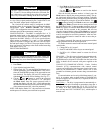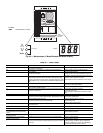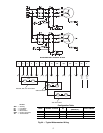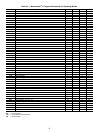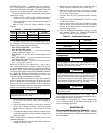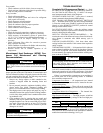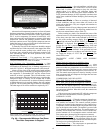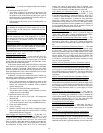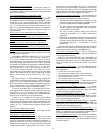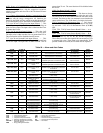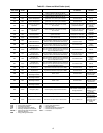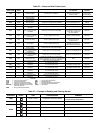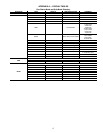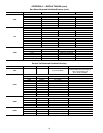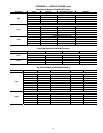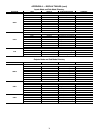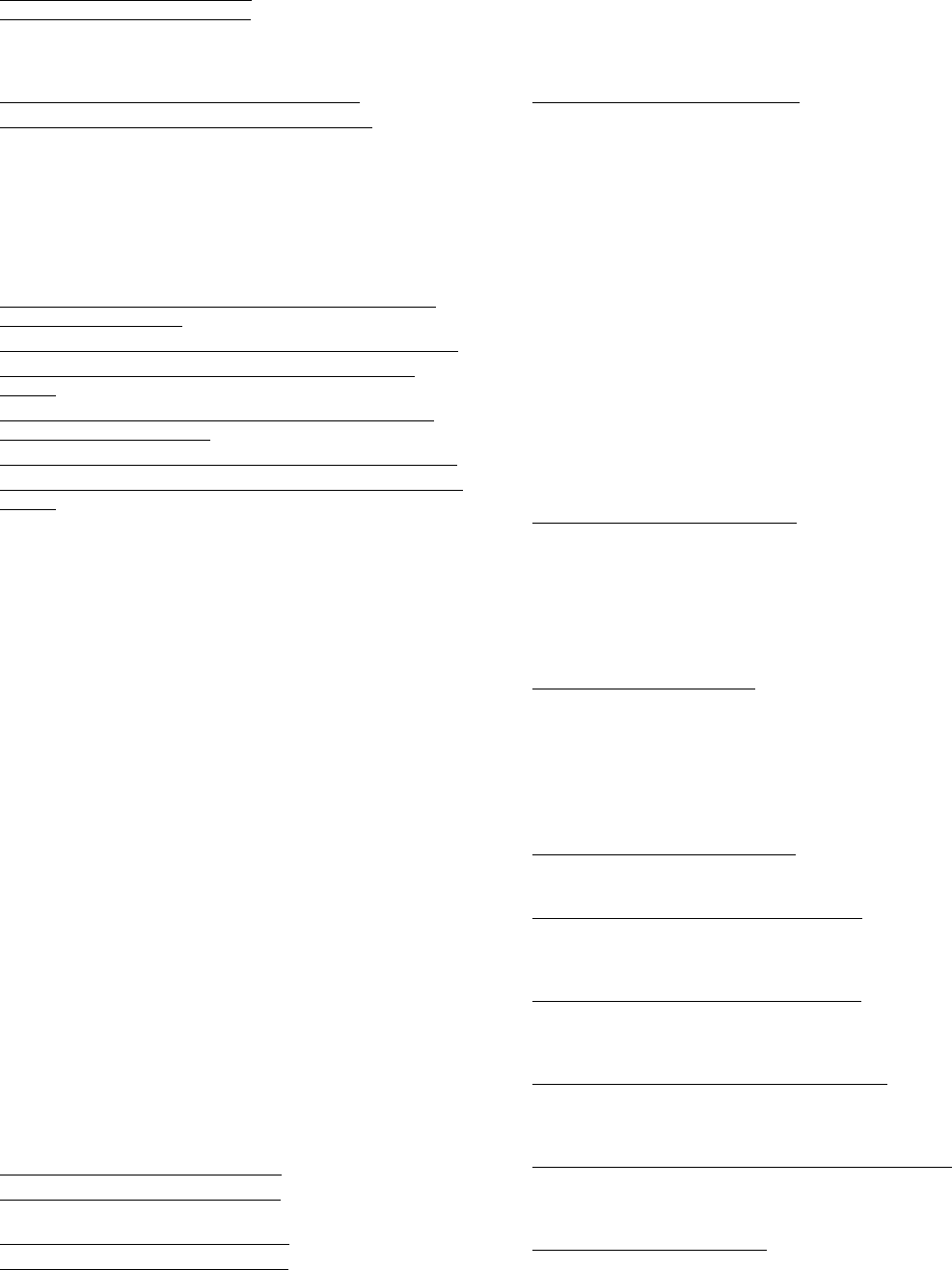
63
T114 (Circuit A Low Superheat)
T115 (Circuit B Low Superheat) — Alert codes 114 and 115
occur when the superheat of a circuit is less than 5 F (2.8 C) for
5 continuous minutes. The low superheat alert is generated and
the circuit is shut down.
T118 (High Discharge Gas Temperature Alert)
A118 (High Discharge Gas Temperature Alarm) — This
alert or alarm occurs for units which have the digital compres-
sor installed on circuit A. If discharge gas temperature is great-
er than 268 F (131.1 C), the circuit will be shut off. The alert
will reset itself when discharge temperature is less than 250 F
(121.1 C). If this alert occurs 3 times within a day, the A118
alarm will be generated and the alarm must be reset manually.
The cause of the alert is usually low refrigerant charge or a
faulty thermistor.
P120 (Circuit A Low Saturated Suction Temperature —
Compressor Shutdown)
T120 (Circuit A Low Saturated Suction Temperature Alert)
A120 (Circuit A Low Saturated Suction Temperature
Alarm)
P121 (Circuit B Low Saturated Suction Temperature —
Compressor B2 Shutdown)
T121 (Circuit B Low Saturated Suction Temperature Alert)
A121 (Circuit B Low Saturated Suction Temperature
Alarm) — This alert or alarm is used to keep the evaporator
from freezing and the saturated suction temperature above the
low limit for the compressors.
When SSTA or SSTB is less than 20 F (–6.7 C) for 4 min-
utes, less than 10 F (–12.2 C) for 2 minutes, less than 0° F
(–17.8 C) for 1 minute, or less than –20 F (–28.9 C) for 20 sec-
onds continuously, one compressor of the affected circuit will
be shut down with a local alert (P120, P121) and a 10-minute
time guard will be added to the compressor. If saturated suction
temperature continues to be less than 20 F (–6.7 C) for 4 min-
utes, less than 10 F (–12.2 C) for 2 minutes, less than 0° F
(–17.8 C) for 1 minute, or less than –20 F (–28.9 C) for 20 sec-
onds continuously, then another compressor will be shut down
until the last compressor on the circuit is shut down at which
time an alert or alarm will be issued (T120, T121, A120,
A121).
This failure follows a 3 strike methodology whereby the
first two times a circuit goes down entirely, an alert will be gen-
erated (T120, T121) which keeps the circuit off for 15 minutes
before allowing the circuit to try again. The third time this hap-
pens, an alarm (A120, A121) will be generated which will ne-
cessitate a manual reset to get the circuit back running.
To recover from these alerts, a 10-minute hold off timer
must elapse and the saturated suction temperature must rise
above 29.32 F (–1.5 C). If recovery occurs, staging will be al-
lowed on the circuit again. Therefore, it is possible that multi-
ple P120 or P121 alerts may be stored in the alarm.
If there are 1 or 2 strikes on the circuit and the circuit
recovers for a period of time, it is possible to clear out the
strikes thereby resetting the strike counter automatically. The
control must have saturated suction temperature greater than or
equal to 34 F (1.1 C) for 60 minutes in order to reset the strike
counters.
T122 (Circuit A High Pressure Trip)
T123 (Circuit B High Pressure Trip) — Alert codes 122 and
123 are for circuits A and B respectively.
T126 (Circuit A High Head Pressure)
T127 (Circuit B High Head Pressure) — Alert codes 126 and
127 are for circuits A and B respectively. These alerts occur
when the appropriate saturated condensing temperature is
greater than 150 F (65.6 C). Prior to the alert, the control will
shut down one compressor on a circuit if that circuit's saturated
condensing temperature is greater than 145 F (62.8 C). If SCT
continues to rise to greater than 150 F (65.6 C), the alert will
occur and the circuit's remaining compressor will shut down.
The cause of the alarm is usually an overcharged system, high
outdoor ambient temperature coupled with dirty outdoor coil,
plugged filter drier, or a faulty high-pressure switch.
A140 (Reverse Rotation Detected)
— A test is made once, on
power up, for suction pressure change on the first activated cir-
cuit. The unit control determines failure as follows:
1. The suction pressure of both circuits is sampled 5 seconds
before the compressor is brought on, right when the com-
pressor is brought on and 5 seconds afterwards.
2. The rate of suction pressure change from 5 seconds be-
fore the compressor is brought on to when the compres-
sor is brought on is calculated.
3. The rate of suction pressure change from when the
compressor is brought on to 5 seconds afterwards is
calculated.
4. With the above information, the test for reverse rotation is
made. If the suction pressure change 5 seconds after com-
pression is greater than the suction pressure change 5 sec-
onds before compression – 1.25, then there is a reverse
rotation error.
This alarm will disable mechanical cooling and will require
manual reset. This alarm may be disabled once the reverse ro-
tation check has been verified by setting REV.R = Yes.
A150 (Unit is in Emergency Stop)
— If the CCN emergency
stop command is received, the alarm is generated and the unit
will be immediately stopped.
If the CCN point name "EMSTOP" in the system table is set
to emergency stop, the unit will shut down immediately and
broadcast an alarm back to the CCN, indicating that the unit is
down. This alarm will clear when the variable is set back to
"enable."
A151 (Illegal Configuration)
— An A151 alarm indicates an
invalid configuration has been entered. The following are ille-
gal configurations.
• Invalid unit size has been entered.
• Dual thermostat configured for single-circuit unit.
• Dual thermostat and switch demand limit configure
• AUX board incorrect revision.
• Unit configuration set to invalid type.
A152 (Unit Down Due to Failure)
— Both circuits are off
due to alerts and/or alarms. Reset is automatic when all alarms
are cleared. This alarm indicates the unit is at 0% capacity.
T153 (Real Time Clock Hardware Failure)
— A problem
has been detected with MBB real time clock hardware. Try re-
setting the power and check the indicator lights. If the alarm
continues, the board should be replaced.
A154 (Serial EEPROM Hardware Failure)
— A problem
has been detected with the EEPROM on the MBB. Try reset-
ting the power and check the indicator lights. If the alarm con-
tinues, the board should be replaced.
T155 (Serial EEPROM Storage Failure Error)
— A problem
has been detected with the EEPROM storage on the MBB. Try
resetting the power and check the indicator lights. If the alert
continues, the board should be replaced.
A156 (Critical Serial EEPROM Storage Failure Error)
— A
problem has been detected with the EEPROM storage on the
MBB. Try resetting the power and check the indicator lights. If
the alarm continues, the board should be replaced.
A157 (A/D Hardware Failure)
— A problem has been detect-
ed with A/D conversion on the boards. Try resetting the power
and check the indicator lights. If the alarm continues, the board
should be replaced.



